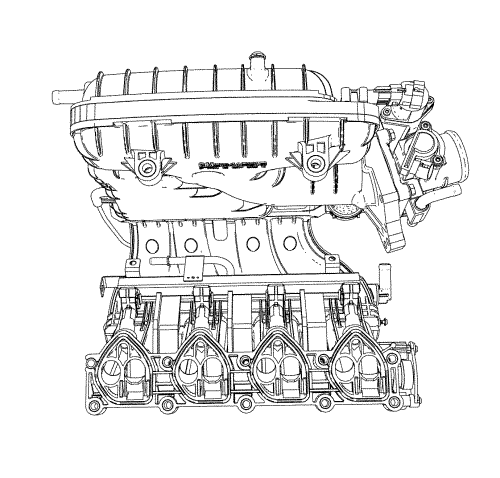Air Inlet System Description
Circuit/System Description
The primary function of the air inlet system is to provide filtered air to the engine. The system uses a filter-element mounted in a housing. The filter-housing is remotely mounted and uses inlet ducts to route the incoming air into the throttle body. The secondary function of the air inlet system is to muffle air induction noise. This is achieved by the use of resonators attached to the air inlet ducts. The resonators are tuned to the specific powertrain. The inlet air temperature (IAT) sensor is used to measure the temperature of the air entering the engine.
Port Deactivation Intake Manifold Runner Control Valve

The characteristic torque curve of a normally aspirated engine depends mainly on how the engines average pressure changes over the engine speed range. The average pressure is proportional to the volume of the air mass present in the cylinder when the intake valve is closed. The design of the intake system determines how large an air mass can be drawn into a cylinder at a given engine speed. Unlike the resonance intake manifold tuning that varies the intake runner length, the port deactivation intake manifold runner control uses the port deactivation valves in order to achieve maximum performance and efficiency over the entire operating range of the engine. These valves are located in the intake manifold, mounted one of each cylinder's intake ports.
The port deactivation valve flap is normally open. When the engine speed and load are below a calibrated threshold, the ECM provides a ground to the port deactivation valve solenoid, energising the port deactivation valve solenoid and allowing a vacuum from the vacuum tank to be applied to the port deactivation valve actuator. Then the actuator closes the port deactivation valve for an increased charge velocity in the intake port and for a swirl in the combustion chamber, which increases thermal efficiency. During higher engine speeds and loads, the port deactivation valve returns to the open position.
The port deactivation intake manifold tuning system consists of the following components:
| • | The port deactivation (PDA) valve solenoid |
| • | The port deactivation (PDA) valve actuator |
| • | The port deactivation (PDA) valve |
Ignition voltage is supplied directly to the port deactivation solenoid valve. The engine control module (ECM) controls the port deactivation solenoid valve by grounding the control circuit via an internal driver switch. The primary function of the driver is to supply ground for the port deactivation solenoid valve. The ECM can determine if the control circuit is open, shorted to ground, or shorted to a voltage by monitoring the voltage on the control circuit.
| © Copyright Chevrolet. All rights reserved |
